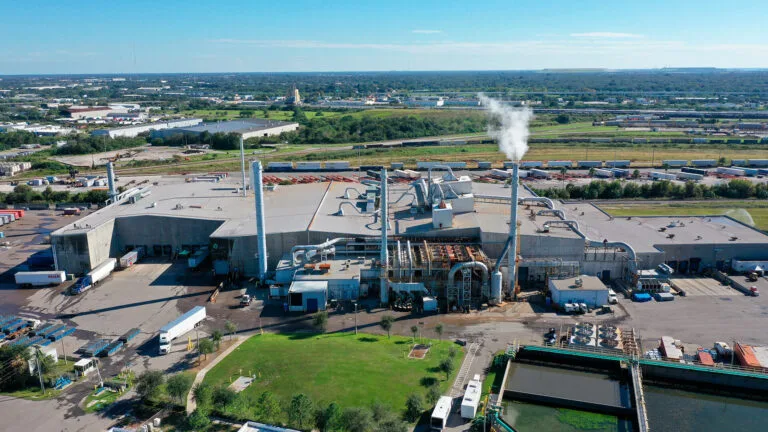Tampa Lead Factory Incurs More Problems

May 28, 2021
Share
Toxic fumes billow out from the furnace inside the east Tampa lead smelter, escaping exhaust hoods meant to capture them, floating into the workspace and creating a haze above a dusty floor. A worker emerges from the fog.
The scene Sunday at Gopher Resource was captured on video by an employee to document ongoing problems with the plant’s long-troubled ventilation system and shared with the Tampa Bay Times. The footage was taken from an area inside the plant with historically high worker exposures to lead and while a federal Occupational Safety and Health Administration inspection of the factory remains active.
Regulators have spent nearly two months at the plant in the wake of a Times investigation published in March that found hundreds of Gopher workers were exposed to high amounts of lead and other chemicals. Levels of lead in the air ascended to hundreds of times the federal limit, surpassed the protection capability of company-issued respirators and at times even reached life-threatening concentrations.
The newsroom’s investigation found that mechanical problems over the past decade contributed to the neurotoxin and poisonous gases spilling into the workspace. Inspections riddled with errors and a years-long absence from regulators further allowed dangerous conditions in the plant to persist.
Read more: POISONED: Part 1: The Factory
OSHA has said little about its current inquiry, which began April 5. Regulators have reviewed documents, conducted air sampling and collected dust samples from around the plant.
Three workers said that after the regulatory probe began, employees in high exposure areas were outfitted in more protective respirators.
OSHA said regulators have six months to complete an inspection but did not say when the agency anticipates being done at Gopher. The agency did not respond to specific questions about ventilation issues at the plant, including how problems were still occurring during the open inspection.
But in response to the video showing plumes of smoke emitting from the furnace, the agency said it was “actively evaluating the conditions.”
In a statement to the Times, Gopher initially denied any problems with the furnace depicted in the video but acknowledged issues with another furnace that the company said it had immediately handled. After reporters shared a copy of the video with company leaders, Gopher provided a second statement that, in part, said: “We have addressed and resolved the issue.”
The company did not respond to questions about the underlying cause of the fumes entering the work environment or what fixes were made.
“Gopher Resource is focused on operating our plant safely and protecting our workers,” the company said.
Earlier this month, Gopher took out a full-page ad in the Times to publish an open-letter to the community. In the letter, CEO Brian Leen wrote that the company had made safety enhancements and said he anticipated the ongoing inspection would help Gopher prioritize ways to make further improvements. Neither Gopher nor OSHA answered questions about whether regulators have shared any preliminary findings with company leaders thus far.
Leen also said in the letter that he has relocated from Gopher’s headquarters in Eagan, Minn., to Tampa to personally oversee operations and make the plant’s success his top priority.
The Gopher factory is the only lead smelter in Florida. Lead-acid batteries that power cars are recycled at the plant so that the metal inside them can be reclaimed.
The process works by extracting the lead from used batteries, melting it in furnaces and purifying it through the addition of chemicals in the refinery. It’s then molded into new blocks that are sold to other companies, like battery and ammunition manufacturers.
The OSHA inspection is the first the agency has conducted at the plant in five years. After the Times’ investigation published, U.S. Rep. Kathy Castor, D-Tampa, and U.S. Rep. Charlie Crist, D-St. Petersburg, called on the agency to swiftly take action.
Read more: POISONED: Part 2: The Failings
In the days and weeks before regulators arrived, the company prepared by installing mats to suction lead dust off workers’ shoes as they leave the factory, replacing a sludge-caked floor where batteries are cracked open and making fixes meant to improve the plant’s ventilation system.
But four workers have told the Times that repairs made to the ventilation system earlier this year haven’t stopped problems from occurring in the furnace department. The video shot Sunday showing emissions pouring from the glowing furnace, two said, is just one example of ongoing issues.
Four years ago, consultants hired by the company found problems with fumes spilling out from the same furnace area. Photos and videos taken by workers in 2019, 2020 and this year appear to show a similar issue occurring. Some depict a workspace so smokey, there are near white-out conditions.
Three workers have said regulators have evaluated the plant’s ventilation system, but OSHA would not answer questions about actions the agency has taken, citing the open inspection.
Officials have also called for reviews of the plant’s impact on the surrounding community.
Last month, Hillsborough County Commissioner Gwen Myers organized a town hall for the neighborhood around the factory and requested that the health department provide blood-lead testing for children who live near the plant. The plant is a half-mile from Kenly Elementary in an area that is a mix of heavy industry, small auto-repair and tire shops and residential homes.
Read more: County will provide testing for neighbors of Florida’s lead smelter
More than 30 children were tested May 1 at Kenly Park and none had an elevated blood-lead level, said Kevin Watler, a spokesman for the Florida Department of Health in Hillsborough County.
Castor also asked the U.S. Environmental Protection Agency for an expedited review of the plant’s operations.
The county’s Environmental Protection Commission, which enforces federal air-quality standards, opened an inspection last month that remains pending.
The problems at Gopher also have caught the attention of credit-rating agencies, Moody’s Investors Service and S&P Global.
Both agencies said a credit-rating downgrade was possible for Gopher, which could affect the company’s ability to borrow money. A Moody’s spokeswoman said the review is ongoing. A spokesman for S&P Global said Gopher remains on credit watch with negative implications.
The credit agencies have cited the ongoing regulatory inspection, Times’ reports of high employee exposures to chemicals and Gopher’s existing amount of debt compared to equity as reasons for a possible downgrade. They will consider whether Gopher, which brought in roughly $360 million in revenue last year, can continue operating its Tampa factory at the same capacity; whether regulators will issue any fines; and whether Gopher will be required to make repairs that could be costly.
This story is part of a collaboration with the Tampa Bay Times through FRONTLINE’s Local Journalism Initiative, which is funded by the John S. and James L. Knight Foundation and the Corporation for Public Broadcasting.
Latest Documentaries
Related Stories
Related Stories
Explore
Policies
Teacher Center
Funding for FRONTLINE is provided through the support of PBS viewers and by the Corporation for Public Broadcasting, with major support from Ford Foundation. Additional funding is provided the Abrams Foundation, Park Foundation, John D. and Catherine T. MacArthur Foundation, Heising-Simons Foundation, and the FRONTLINE Trust, with major support from Jon and Jo Ann Hagler on behalf of the Jon L. Hagler Foundation, and additional support from Koo and Patricia Yuen. FRONTLINE is a registered trademark of WGBH Educational Foundation. Web Site Copyright ©1995-2025 WGBH Educational Foundation. PBS is a 501(c)(3) not-for-profit organization.





















